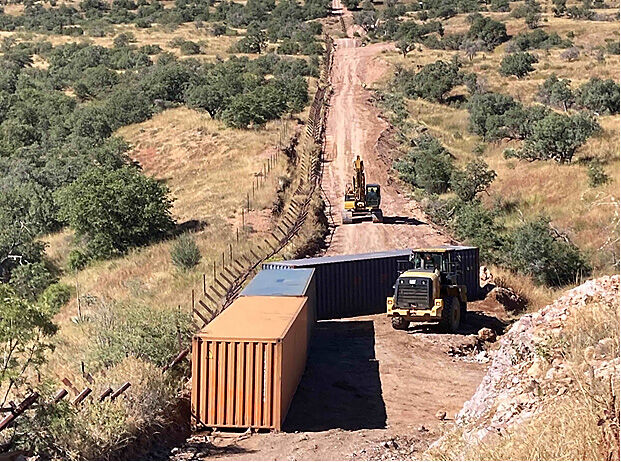Arizona is erecting a shipping-crate border barrier along a 10-mile stretch of federal land just west of the Coronado National Memorial in Cochise County, where there’s currently no border wall.
The state is moving forward with the project estimated to cost about $95 million despite a standoff with the federal government over Arizona installing border barriers on federal land without permission.
About 3,000 shipping containers are expected to be installed in Cochise County by the same company, emergency management contractor AshBritt, that put up 3,800 feet of shipping crates over 11 days in Yuma. That project is near the Morelos Dam, where many undocumented migrants have been crossing into Ariozona in the last year.
The new barrier will fill a gap in the existing border barrier, says Gov. Doug Ducey’s spokesman C.J. Karamargin.
Last week’s standoff with the federal government began when they asked the state to remove the Yuma containers, saying it was an “unauthorized placement’’ on federal property and on Cocopah Indian Tribe land.
The Arizona Department of Emergency and Military Affairs responded with a letter saying the state is within its rights to construct a border barrier of shipping containers on federal land in the Yuma area and will not remove it, citing the U.S. Constitution and various legal statues.
And Coronado Forest Supervisor Kerwin Dewberry sent a letter to the state saying it needed to obtain prior approval through the federal regulatory approval process that governs National Forest Land before placing any barriers on there, which the state did not do.
The federal government waived dozens of laws to speed up wall construction under the Trump administration, including the requirement to review environmental impacts, when it built much of the existing barrier using of the 2005 REAL ID Act, which contains a provision that allows the secretary of Homeland Security to waive laws that interfere with construction of physical barriers at the borders. But the state had no such jurisdiction.
The state’s response escalated when Arizona filed a complaint in federal court Friday saying, among other things, that President Theodore Roosevelt had no legal right to declare all that land along the border, now known as the Roosevelt Reservation, to be the property of the federal government. The Roosevelt Reservation is a 60-foot wide swath of land that runs along most of the border in Arizona as well as California and New Mexico.
The complaint also notes that an increase in undocumented migrants at the border has “put a strain on domestic resources, which is felt most acutely by border communities.” Federal law enforcement at the Arizona border encountered migrants 571,720 times in fiscal year 2022, according to federal data released Friday, an 83% increase over last year.
“Local communities have reported strain on their ability to provide needed social services,” the complaint says. “Local officials and NGOs report that the temporary shelters that house migrants are quickly reaching capacity due to the high number of arrivals, and stakeholders in the border region have expressed concern that shelters will eventually reach full bed space capacity and not be able to host any new arrivals.”
Many local nonprofits, such as Casa Alitas in Tucson, have had to expand their services to accommodate larger numbers of migrants passing through the state, much of which is covered by federal grants from FEMA.
The barrier the state erected in Yuma didn’t stop migrants from entering the country, and the area saw a 5% increase in migrant encounters the month after the barrier was installed.
Filling a 10-mile gap in the Coronado National Forest would be “devastating to wildlife and will do nothing to stop the movements of humans,” says Robin Silver, a cofounder at the Center for Biological Diversity, which filed a court notice last week of its intent to sue over Arizona’s planned use of the shipping containers.
“Any human that has access to anything like a cheap Home Depot cutting blade or cutting saw can move through the walls…. It literally takes a human less than 10 minutes to walk through the wall now, but wildlife cannot go to Home Depot and buy a cutting saw,” Silver said.
This area is a documented established movement corridor for wildlife, including endangered wildlife like jaguars and ocelots, Silver said.
As well, even without a wall currently there, large numbers of people don’t go through that area due to the number of border patrol agents, helicopters, drones and hundreds of monitored cameras in the area, he said.
“The bottom line here is that this is just a publicity stunt by the governor,” he said.
Arizona Governor Doug Ducey shared a video Thursday morning showing the progress of a shipping-crate border barrier being built in Southern Arizona west of the Coronado National Memorial. According to Ducey, nearly one mile of the planned 10-mile structure has been erected. Video courtesy Doug Ducey.





